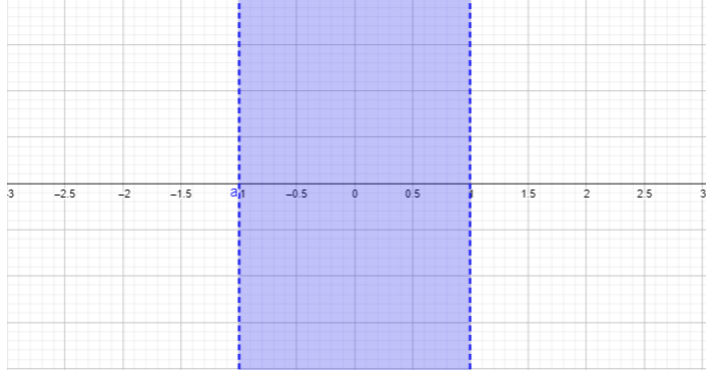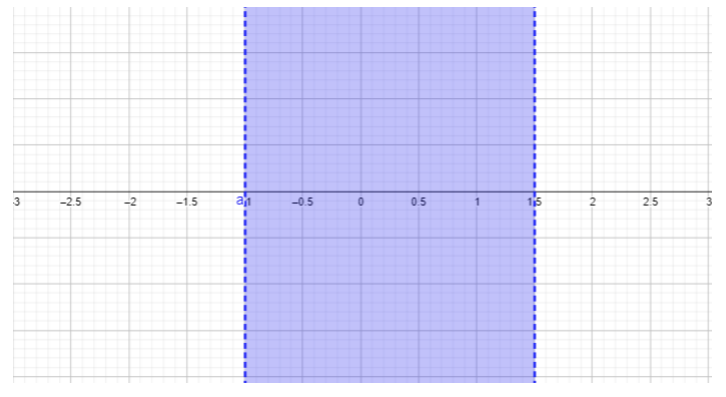10.3: 理性不平等
- Page ID
- 171341
求解有理不等式需要找到分子和分母的零,然后使用这些值调查数字线上的解集区域。
求解不等式并用区间表示法写出解集:
- \(\dfrac{x − 1}{x + 1} ≥ 0\)
- \(\dfrac{2x − 3}{x + 1} ≤ 0\)
- \(\dfrac{x + 2}{x − 2} ≥ 0\)
解决方案
- \(\begin{array} &&\dfrac{x − 1}{x + 1} ≥ 0 &\text{Example problem} \\ &\dfrac{x − 1}{x + 1} ≥ 0 &\text{The quotient must be greater than or equal to \(0\).}\\ &x − 1 = 0,\; x = 1 &\ text {找到分子的零}\\ &x + 1 = 0, x =\; −1 &\ text {找到分母的零}\ end {array}\)

\(\begin{array} &&\text{For } x < −1, \text{ choose } x = −2. \;\;\dfrac{−2 − 1}{−2 + 1} = \dfrac{−3}{−1} = 3 ≥ 0 \\ &\text{Replacing \(-2\)表示答案中的\(x\)结果\(3\),该结果大于或等于\(0\)。 \(x < −1\)该区域包含在解决方案集中。}\\ [0.25in] &\ text {For} −1 < x < 1,\ text {choose} x = 0。\;\ dfrac {0 − 1} {0 + 1} = −1 < 0\\ &\ text {替换\(0\)答案中的\(x\)结果\(-1\),小于\(0\),不满足问题中给定的不等式。}\\ &\ text {此区域\(−1 < x < 1\)不包括在解集中。}\\ [0.25in] &\ text {For} x > 1,\ text {choose} x = 2.\;\;\ dfrac {2 + 1} {2 + 1} =\ dfrac {1} ≥ 0\\ &\ text {替换\(2\)答案中的\(x\)结果\(\dfrac{1}{3}\),哪个是大于或等于\(0\)。 \(x > 1\)该区域包含在解集中。}\\ [0.25in] & (−∞, −1) (1, ∞)\\ &\ text {用区间表示法书写的最终答案(有关更多详细信息,请参阅区间表示法部分)。} \ end {array}\)
- \(\begin{array} &&\dfrac{2x − 3}{x + 1} ≤ 0 &\text{Example problem} \\ &\dfrac{2x − 3}{x + 1} ≤ 0 &\text{The quotient must be less than or equal to \(0\).}\\ &2x − 3 = 0,\; x = 1.5 &\ text {找到分子的零}\\ &x + 1 = 0,\; x = −1 &\ text {找到分母的零}\ end {array}\)

\(\begin{array} &&\text{For } x < −1, \text{ choose } x = −2. \;\; \dfrac{2(−2) − 3}{−2 − 1} = \dfrac{−7}{−3} = \dfrac{7}{3} ≥ 0 \\ &\text{Replacing \(-2\)表示答案中的\(x\)结果大于\(\dfrac{7}{3}\)\(0\),未满足问题中给定的不等式。}\\ &\ text {此区域\(x < −1\)不在解集合中。}\\ [0.25in] &\ text {For} −1 < x < 1.5,\ text {choose} x = 0。\;\ dfrac {2 (0) −3} {0 − 1} =\ dfrac {−3} {−1} = 3 ≥ 0\\ &\ text {替换\(0\)答案中的\(x\)结果\(3\),大于或等于\(0\),这不是问题所要求的。}\\ &\ text {解集中不包括该区域\(−1 < x < 1.5\)。}\\ [0.25in] &\ text {For} x > 1,\ text {choose} x = 2。\;\ dfrac {2 (2) − 3} {2 − 1} =\ dfrac {1} {1} = 1 ≥ 0\\ &\ text {替换\(2\)答案中的\(x\)结果\(1\),大于或等于\(0\)。 该区域\(x > 1\)不包含在解决方案集中。}\\ [0.25in] &\\ &\ text {这个问题没有解决方案。 \(\dfrac{2x − 3}{x + 1}\)永远不会小于或等于\(0\)。} \ end {array}\)
- \(\begin{array} &&\dfrac{x + 2}{x − 2} ≥ 0 &\text{Example problem} \\ &\dfrac{x + 2}{x − 2} ≥ 0 &\text{The quotient must be greater than or equal to \(0\).}\\ &x + 2 = 0,\;\; x = −2 &\ text {找到分子的零}\\ &x − 2 = 0,\;\; x = 2 &\ text {找到分母的零}\ end {array}\)

\(\begin{array} &&\text{For } x < −2, \text{ choose } x = −3. \dfrac{−3 + 2}{−3 − 2} = \dfrac{−1}{−5} = \dfrac{1}{5} ≥ 0 \\ &\text{Replacing \(-3\)表示答案中的\(x\)结果\(\dfrac{1}{5}\),该结果大于或等于\(0\)。 \(x < −2\)该区域包含在解决方案集中。}\\ [0.25in] &\ text {For} −2 < x < 2,\ text {choose} x = 0。\;\ dfrac {0 + 2} {0 − 2} = −1 < 0\\ &\ text {替换\(0\)答案中的\(x\)结果\(-1\),小于\(0\),不满足问题中给定的不等式。}\\ &\ text {此区域\(−2 < x < 2\)不包含在解集中。}\\ [0.25in] &\ text {For} x > 2,\ text {choose} x = 3.\;\ dfrac {3 + 2} {3 − 2} =\ dfrac {5} {1} = 5 ≥ 0\\ &\ text {替换\(3\)\(x\)结果为回答\(5\),它大于或等于\(0\)。 \(x > 2\)该区域包含在解集中。}\\ [0.25in] & (−∞, −2) (2, ∞)\\ &\ text {用区间表示法书写的最终答案(更多详情请参阅区间表示法部分)。} \ end {array}\)
- \(\dfrac{x + 3}{x − 2} ≥ 0\)
- \(\dfrac{x − 2}{x − 1} ≤ 0\)
- \(\dfrac{2x − 1}{x + 2} ≤ 0\)
- \(\dfrac{2x − 3}{x + 1} ≥ 0\)


